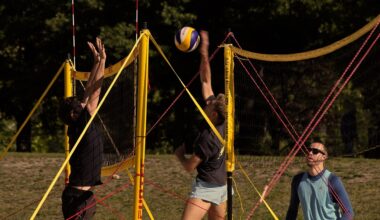Advances in Shoulder Labrum Repair Techniques for Athletes
Shoulder injuries are common among athletes, particularly those engaged in overhead sports like baseball and tennis. One of the prevailing issues in sports medicine is the injury to the shoulder labrum, which can lead to instability and pain. In recent years, new surgical techniques have emerged to address these injuries effectively. Modern arthroscopic methods allow for less invasive approaches, minimizing trauma to surrounding tissues. Innovations in anchor technology and suture materials have also enhanced repair strength and reliability. Furthermore, advanced imaging techniques such as MRI contribute to better diagnosis and treatment planning. Understanding the specific type of labral tear, whether it’s a SLAP or Bankart tear, is critical in determining the appropriate surgical intervention. Comprehensive preoperative assessment, utilizing patient history and physical examination, informs the surgeon’s approach. These advancements are pivotal in ensuring faster recovery times and return to sports. As sports medicine evolves, continuous research into the biomechanics of shoulder anatomy and healing responses is essential. This article explores the best practices and evolving techniques in shoulder labrum repairs for athletes, ensuring optimal performance and long-term health.
Current Surgical Techniques
The evolution of shoulder labrum repair techniques has witnessed significant contributions from arthroscopic surgery, enabling surgeons to achieve precision while minimizing soft tissue damage. Current surgical methods focus on reconstructing the labrum through advanced techniques such as the suture bridge and Mason-Allen stitch strategies. These methods utilize new materials that enhance the stability and strength of the repair. The suture bridge technique provides a broader contact surface, distributing stress along the repair site, while Mason-Allen stitches allow for a strong fixation of the labrum. Another innovative approach is the use of biological augmentation, employing growth factors or scaffolds to promote healing. Surgeons are increasingly using bio-compatible anchors that securely attach the labrum to the bone. These anchors can be made from various materials, ranging from allograft to synthetic substances, each having unique properties that cater to specific injuries. The optimal choice often depends on individual patient factors such as age, activity level, and injury severity. Continuous advancements in surgical technology lead to improvements in restoration success and decreased recovery times for athletes, highlighting the place of innovation in modern sports medicine.
Post-operative rehabilitation is critical in the successful recovery of athletes following shoulder labrum repair. A well-structured rehabilitation program focuses on restoring range of motion, strength, and functional capacity. The timeline for rehabilitation is individualized, often starting with passive range of motion exercises, progressing to active movements as healing permits. Research indicates that incorporating neuromuscular training enhances recovery, facilitating quicker reconditioning of the shoulder’s dynamic stabilizers. Most rehabilitation protocols emphasize muscle activation of the rotator cuff and scapular stabilizers to prevent re-injury. Incorporating sport-specific functional drills at appropriate timelines is essential to ensure athletes safely return to competition. Additionally, biomechanics assessments play a vital role in tailoring rehabilitation exercises, addressing any underlying movement deficiencies. Monitoring progress is also critical, requiring regular evaluations to adapt the rehabilitation plan. The collaboration between surgeons, physical therapists, and athletes allows for a holistic approach, focusing on the athlete’s unique goals and needs. The incorporation of technology, including wearables and motion analysis systems, further enhances rehabilitation efficiency. Understanding the importance of committed rehabilitation guarantees successful outcomes, ensuring athletes can compete without compromising their shoulder health.
Outcomes and Success Rates
Outcomes for patients undergoing shoulder labrum repair have statistically shown promising success rates, particularly with the latest surgical techniques. Studies indicate that athletes can expect restoration of shoulder stability and a significant decrease in pain following surgery, leading to effective return to their sports. Over 90% of athletes report satisfaction post-surgery, with many returning to their pre-injury performance levels. The success of these techniques often relies on proper selection criteria, including athlete age, severity of injury, and concurrent shoulder problems. Long-term outcomes demonstrate that arthroscopic repairs maintain anatomical integrity and promote shoulder health. Regular follow-up assessments are critical to ascertain the durability of the repairs, allowing timely interventions if problems arise. While most athletes face gradual improvement, adherence to rehabilitation protocols greatly influences their recovery progression. Factors like motivation and compliance also play a significant role in determining overall results. Enhanced surgical methods alongside comprehensive rehabilitation strategies contribute to a growing body of evidence supporting the effectiveness of these repairs. Overall, the integration of advanced techniques and patient-centered care models significantly uplifts the standard of shoulder labrum repair for athletes.
In addition to surgical advancements, patient education is gaining importance in the recovery process for athletes. Educating athletes about their specific conditions, expected outcomes, and rehabilitation procedures fosters an enhanced understanding of their injuries. This knowledge allows athletes to play an active role in their recovery, leading to better compliance with rehabilitation protocols. Tools such as multimedia presentations, informational brochures, and one-on-one consultations can be effective in conveying important information. Moreover, explaining the potential risks and benefits associated with surgery empowers athletes to make informed decisions. Engaging athletes in discussions about their rehabilitation timelines and expectations can facilitate better communication and foster trust between providers and patients. Furthermore, incorporating psychological support through counseling tailored to athletes’ needs can be beneficial. Many athletes experience anxiety or uncertainty about returning to sport, and addressing these feelings is crucial for optimal recovery. Building a resilience mindset promotes positive coping strategies as they navigate their post-operative journey. Overall, well-rounded education and psychological support coupled with advanced surgical techniques are fundamental in enhancing recovery outcomes for athletes undergoing shoulder labrum repair.
Future Directions in Sports Medicine
The future of shoulder labrum repair in sports medicine appears promising as researchers and surgeons continuously seek innovative solutions that enhance both surgical techniques and rehabilitation strategies. Exploration of regenerative medicine, including stem cell therapy, holds potential in augmenting healing capabilities and improving long-term outcomes. By utilizing the body’s natural healing mechanisms, these advancements may accelerate repair processes and reduce recovery times. Moreover, wearable technology is revolutionizing monitoring techniques, allowing real-time assessment of shoulder function and biomechanical stress during recovery. This data can inform individualized rehabilitation programs, adjusting exercises based on athlete-specific performance metrics. Additionally, advancements in artificial intelligence are enabling predictive analytics for injury risks by utilizing vast data sets of historical performance outcomes. These insights can lead to preventive strategies reducing injury incidence among athletes. As an interdisciplinary collaboration grows within sports medicine, the knowledge exchanged between surgeons, rehabilitation professionals, and athletes can elevate care standards. Continuous improvements in surgical materials and implant designs are crucial, ensuring athletes not only recover but thrive in their respective sports. Overall, integrating these innovations, patient-centered approaches fosters an exciting future in sports medicine.
In conclusion, advances in shoulder labrum repair techniques markedly enhance the treatment outcomes for athletes. The continual improvement in surgical strategies, coupled with personalized rehabilitation, emphasizes the commitment of sports medicine to athlete health. Understanding various labrum injuries, surgical interventions, and rehabilitation protocols provides a comprehensive outlook on managing shoulder conditions effectively. Additionally, the emphasis on patient education and psychological support underscores an evolving approach to athlete care, recognizing the psychological aspects of recovery. Enhanced post-operative outcomes are directly linked to advancements in surgical technology and materials, providing confidence for athletes returning to their sports. Continued research into regenerative medicine and innovative rehabilitation practices promises to reshape the future landscape of sports medicine. As we move forward, assessing long-term outcomes and the efficacy of novel techniques remain paramount. The integration of proactive and reactive strategies to manage shoulder injuries will minimize the impact on athletes’ careers. Overall, these advancements signify a pivotal shift towards a future where athletes can expect higher success rates and quicker recoveries, ultimately enabling them to perform at their best while safeguarding their health.


